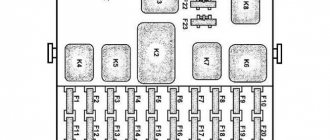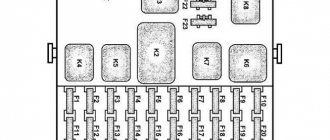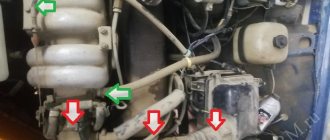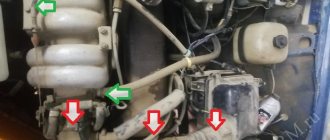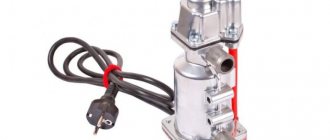Start-Classic for UAZ Patriot with ZMZ-409 engine
The engine starting heater is designed to maintain the required coolant temperature at a certain level.
For example, a temperature of 40°C will provide the necessary conditions in the cylinder for a quick start of the engine, regardless of external conditions. Structurally, the electric heater is an affordable design compared to independent engine starting devices. A conventional heater with the prefix “electro” is a heating element with power wires located in the engine body. Among the advantages of such a device are:
- A simple design that allows you to install it yourself.
- Low cost, which is due to the design features.
- Possibility of later modernization. If necessary, for passenger cars it will be possible to add a timer, fuse sensor and other optional devices.
Before installing an engine heater from a stationary 220V network, get acquainted with the design features. The design is based on a tungsten heating coil located in the cylinder block. Depending on the power, a small volume of antifreeze can be heated relatively quickly.
The main disadvantage is the high energy consumption. In just one night, individual models consume up to 10 kW of electricity. That is why progressive samples are equipped with sensors to periodically disconnect the device from the network.
It is worth noting that the type of engine does not affect the performance of the device. Whether a gasoline or diesel engine is installed on the UAZ, the device is installed in the same way. Here the difference is not as great as matching the tire and wheel sizes for SUVs. With some skill and compliance with safety measures, it is not difficult to assemble an engine pre-heater with your own hands. To avoid unsuccessful experiments, consider the example of an original 220 V car heater.
Purpose and main differences
The engine starting heater is designed to maintain the required coolant temperature at a certain level. For example, a temperature of 40°C will provide the necessary conditions in the cylinder for a quick start of the engine, regardless of external conditions.
Structurally, the electric heater is an affordable design compared to independent engine starting devices. A conventional heater with the prefix “electro” is a heating element with power wires located in the engine body. Among the advantages of such a device are:
Before installing an engine heater from a stationary 220V network, get acquainted with the design features. The design is based on a tungsten heating coil located in the cylinder block. Depending on the power, a small volume of antifreeze can be heated relatively quickly.
The main disadvantage is the high energy consumption. In just one night, individual models consume up to 10 kW of electricity. That is why progressive samples are equipped with sensors to periodically disconnect the device from the network.
It is worth noting that the type of engine does not affect the performance of the device. Whether a gasoline or diesel engine is installed on the UAZ, the device is installed in the same way. Here the difference is not as great as matching the tire and wheel sizes for SUVs. With some skill and compliance with safety measures, it is not difficult to assemble an engine pre-heater with your own hands. To avoid unsuccessful experiments, consider the example of an original 220 V car heater.
Send to a friend
Email heater "SPUTNIK" UAZ DV.UMZ-421
The electric pre-heater AUTO+ SPUTNIK for UAZ models with a UMZ 1.5 kW engine is designed for pre-heating of the coolant of internal combustion engines of vehicles and units in the cold season.
Your friend's name is *:
Your friend's email address *:
Description
The electric pre-heater AUTO+ SPUTNIK for UAZ models with a UMZ 1.5 kW engine is designed for pre-heating of the coolant of internal combustion engines of vehicles and units in the cold season.
Supply voltage, V 220 Power consumption, W no more than 1500 Thermostat response temperature (shutdown), 95°C Thermostat return temperature (switch on), 65°C Electric shock protection class I Moisture protection degree IP34 Installation and operation:
The electric heater must not touch the engine housing or other parts of the vehicle.
The electric heater must be installed in a vertical position with the outlet pipe facing up, with a slight tilt allowed (no more than 15°).
Cut the hose into lengths: inlet hose 400 mm, outlet 230 mm. Secure the bracket to the heater with studs using washers and nuts. Place the sleeves on the corresponding heater pipes and secure the connections with clamps. Open the drain valve and drain the coolant. Open the drain valve. Unscrew the plug with K1/2 thread from the engine cylinder block on the right side along the direction of the vehicle. Clean the holes. Unscrew the engine foot mounting bolt on the right side along the direction of the car. Apply sealant to the threads of the K1/4 fitting and screw it in instead of the drain valve. Apply sealant to the threads of fitting K1/2 and screw it in instead of the plug. Secure the bracket with the heater with the engine foot bolt. Place the clamp on the outlet sleeve. Place the outlet hose on fitting K1/2 and secure the connection with a clamp. Pour 250 ml of coolant through the inlet hose into the heater. Place the inlet hose onto the fitting with a K1/4 thread and secure the connection with a clamp. Fill the cooling system. The power cable should be laid and secured with straps to ensure its safety from mechanical damage, as well as to prevent possible contact with moving and heated parts of the engine. Check the connections for coolant leaks and repair them if present. Start the engine for 3-5 minutes, and after stopping the engine, add coolant to the required level. Preparing for the first launch:
Fill the cooling system, check connections for leaks. Start the car engine and let it run for 5-10 minutes. Then stop the engine and add coolant if necessary. Connect the electric heater to the network. After 2-5 minutes of operation of the electric heater, check the inlet and outlet hoses. The outlet sleeve must be warmer than the inlet sleeve. Precautionary measures:
The heater can be operated only after the engine has warmed up to operating temperature (the thermostat must be open) and the efficiency of the interior heater has been checked. This must be done to eliminate air locks in the cooling system. It is prohibited to use electrical extension cords without a grounding wire and rated for a current of less than 15 A. It is prohibited to plug in the electric heater with the cover removed. Do not use the heater if there is no coolant in it.
ATTENTION. Our stock is replenished daily, so not all stock may be displayed. For complete information, please contact our consultants by toll-free number.
Installation of Severs M on UAZ Patriot with engine 409.10
- Discuss
Installation of Severs M on a UAZ Patriot with engine 409.10 model since 2011.
The Severs M coolant heater is embedded in the system and connected to 220 V. It works on the principle: The coolant (antifreeze) heats up and, expanding, displaces the colder one, ensuring directed circulation of the liquid through electric heater and engine cooling jacket.
For installation you will need installation kit No. 33
Prepare: tools – wrenches; screwdriver (for tightening clamps); sealant type "Avtosil" (for sealing threaded connections); knife (for cutting hose); coolant (coolant) in the amount of 1 liter; container for draining coolant.
Cut the rubber sleeve into pieces: output sleeve L2=390 mm; inlet sleeve L1=350 mm.
Secure the bracket to the heater with studs through the bushings using washers and nuts
Place the sleeves on the corresponding heater pipes and secure the connections with clamps.
Remove the protection (engine splash guard) on the left side.
Unscrew the drain plug from the engine block (Fig. 3) and drain the coolant.
Unscrew the front steering gear mounting bolt
(Fig. 2 arrow B).
Secure the bracket with the heater with the steering gear bolt through the washer included in the kit.
Cut the hose connecting the expansion tank to the lower radiator hose at the lowest point that allows you to install a tee, see fig. 4.
Having first put on the S20-32 clamps, install the tee in the hose gap, so that the side outlet is directed to the heater.
Place the outlet hose with a clamp on the fitting installed instead of the plug, secure the connection with a clamp (it is possible to trim the outlet hose to avoid kinks).
Pour 250 ml of coolant into the heater through the inlet sleeve.
Place a clamp on the inlet sleeve and put the sleeve on the tee outlet, then secure the connection with the clamp.
Fill the cooling system.
The power cable should be laid and secured with straps to ensure its safety from mechanical damage, as well as to prevent possible contact with moving and heated parts of the engine.
Check connections for coolant leaks and repair if present. Start the engine for 3-5 minutes, and after stopping the engine, add coolant to the required level.
Turn on the heater to a 220 V network (after a few seconds you will hear the noise of the heating coolant), check the heating of the outlet hose. After 3-5 minutes, turn off the heater.
go_patriot
An autonomous heater is the most necessary thing in an expedition vehicle, I promise. Even for a car designed exclusively for hunting and fishing, it is highly desirable. All sorts of locks, trunks and power bumpers are secondary.
How often do you climb where you need blocking? How often does the volume of a shmurdyak require a roof rack? That's the same! But we have cool weather from August to June. Sometimes it’s colder, sometimes it’s warmer, but you always want to sleep in comfort, this is the key to a good mood and romantic impressions from a route of any difficulty category.
Installation of pre-heater on UAZ 3303
As usual, winter crept up unnoticed and it was urgently necessary to resolve the issue of installing a pre-heater on the UAZ 3303.
Let's look at the main steps for installing a heater on a UAZ 3303.
- Selecting a preheater
- Pre-heater installation location
- Installation of pre-heater
- Choosing an autonomous heater for a UAZ :)
Selecting a pre-heater for UAZ 3303
The Chinese Xin Ji (Longfei) (power 2 kW) with a pump was chosen as the engine heater. It should be noted that the pump significantly speeds up engine warming up. In addition, the pump eliminates overheating of individual engine elements due to uniform heating.
Device (photo from instructions)
Usually, heaters with a pump are simply plugged into the stove line.
You just need to take into account the direction of movement of the coolant so that when the engine is running, there is no backflow for the running pump. This is necessary in case you forget to turn off the heating and start the engine.
see the diagram of the movement of coolant in the UMZ 417 engine
As you can see from the picture, the coolant comes from the tap on the engine and goes to the pump.
Installation location of the pre-heater on UAZ 3303
For a very long time I could not decide on where to install the heater. Despite the fact that there is a lot of free space in the engine compartment of the UAZ))
The heater is embedded in the heater return hose
A suitable bolt behind the master cylinder is selected as the location for the heater.
Installation of pre-heater on UAZ 3303
With this installation you will not need an additional hose. Only two clamps are needed.
It is worth noting that a heater with a pump warms up the engine much faster compared to a conventional boiler (a conventional heater is in my wife’s Toyota car, I’m now thinking of changing it to a heater with a pump too).
The issue price is 1000 rubles. (took from Fortuna in Irkutsk)
Choosing an autonomous engine heater for a UAZ
For those who need an autonomous heater for a UAZ, they can use the hint in this photo.
The photo shows the interior of a UAZ Bukhanka car. The antifreeze is connected to the stove and circulates during the fire to warm up the engine.
Types of heaters, features
The company offers a choice of a number of models with different designs and technical characteristics. In most cases, the devices are intended for use on domestic cars and trucks - VAZ, GAZ, UAZ, GAZelle, etc. But at the same time, installation of the Alliance heater is quite possible on foreign cars.
The catalog of preheaters from this company includes the following models:
"Alliance-2-PC"
The only tank-type model on the list, the design of which includes a pump that circulates coolant through the system while the heater is operating. Thanks to this, it ensures more uniform heating of the cylinder block. The equipment has a vertical design. The power of the heating element is 2 kW;
This model comes in two types - 1.5 and 2.0 kW. Externally, it is identical to the model with a pump, but this version does not have a pump. Liquid circulation – gravity;
"Alliance -07"
Horizontal flow-type model with perpendicular pins. Designed for installation on vehicles that use a shortened cooling system return pipe and an angled antifreeze supply to the thermostat housing (VAZ classic models and some front-wheel drive models). The power of the heating element is only 0.7 kW, so it is more suitable for maintaining temperature rather than heating coolant;
"Alliance-08" and "08 Universal"
Flow model with horizontal position of terminals. The first version is intended for installation on GAZ cars, while the second is universal and can be used on foreign cars. Heater power – 0.8 kW;
Horizontal tank-type model with perpendicular outlets and a power of 3 kW. This heater is designed for use with truck engines;
The type of device affects the principle of operation. If everything is clear with a tank heater equipped with a pump - when turned on, the pump provides circulation, then gravity-fed ones should be considered in more detail, since the scheme of its operation is quite interesting.
Description and installation of the Alliance heater on a VAZ car
In search of means to ensure easy starting of the power plant in conditions of reduced temperatures, many car owners opt for antifreeze pre-heaters operating from a 220 V network. In such devices, powerful heating elements ensure fairly quick warm-up of the engine in winter.
At the same time, motorists often give preference to such domestically produced devices, including the Alliance pre-heater.
This decision is often due to the fact that domestic devices are cheaper than foreign ones, with decent build quality and acceptable performance of their functions.
This manufacturer has appeared on the market of equipment for heating power plants quite a long time ago, and its products are in demand.
When installing the Longfei heater, follow the recommendations
We connect it to the stove using hoses.
I’ll say right away that I am against loans and taking a car, especially not a new one, on credit is unreasonable. High-quality sealing of all joints is ensured by a set of gaskets and clamps.
The main chamber of the device is made of stainless steel, so it keeps the temperature high.
When installing the Longfei heater, follow the recommendations. Do not leave the Longfei turned on overnight. But you won’t have to warm it up at idle for a long time.
Do not turn on the engine heater if there is no coolant in the cooling system. It is precisely the preheating of the engine that is the task of the heater.
As a result of using cheap heating elements, high temperatures “kill” antifreeze, or rather its anti-corrosion, anti-foaming additives, etc. The bracket is attached to the heater boiler. Before you begin installation, consult with experienced people who have positive experience or look into the service of experts.
Known types of devices
A preheater operating from a V network consumes quite a lot of electricity, since the heating element installed inside the device has a fairly high power. It is located immediately above the tubular electric heater. In this way, the driver has the opportunity to take care of the environment. Installing a preheater with your own hands Installing a preheater with your own hands will not require a lot of time and any special knowledge.
They can be installed in any free space under the hood of the car. Most car owners have their cars idle overnight in the open air or in a regular garage, at best. You need to connect a longer piece to the input, and a shorter piece to the output. Parallel connection diagram for electric heaters Video with an example of self-installation of the Longfei pre-heater on a car Published on the official channel of user Nikolay Beketov. Installation of a 2.2 kW "longfey" preheater with a pump on a Toyota Corolla


